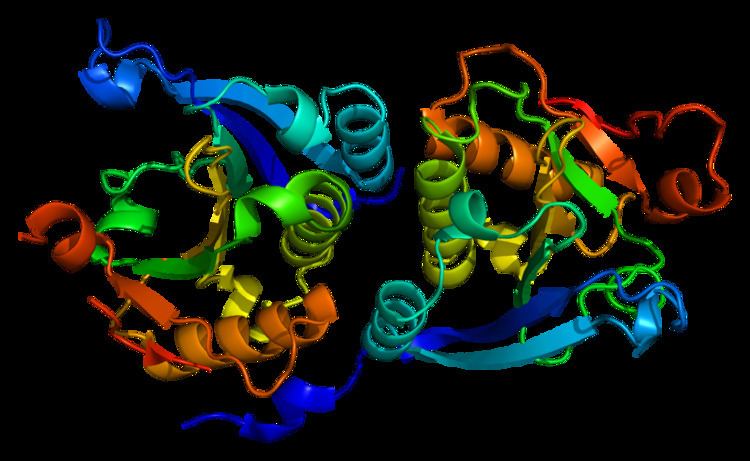Entrez 1977 | Ensembl ENSG00000151247 | |
 | ||
Aliases EIF4E, eukaryotic translation initiation factor 4E, AUTS19, CBP, EIF4E1, EIF4EL1, EIF4F, eIF-4E External IDs MGI: 95305 HomoloGene: 123817 GeneCards: EIF4E | ||
Eukaryotic translation initiation factor 4E, also known as eIF4E, is a protein that in humans is encoded by the EIF4E gene.
Contents
Structure and function
All eukaryotic cellular mRNAs are blocked at their 5'-ends with the 7-methyl-guanosine five-prime cap structure, m7GpppX (where X is any nucleotide). This structure is involved in several cellular processes including enhanced translational efficiency, splicing, mRNA stability, and RNA nuclear export. eIF4E is a eukaryotic translation initiation factor involved in directing ribosomes to the cap structure of mRNAs. It is a 24-kD polypeptide that exists as both a free form and as part of the eIF4F pre-initiation complex. Almost all cellular mRNA require eIF4E in order to be translated into protein. The eIF4E polypeptide is the rate-limiting component of the eukaryotic translation apparatus and is involved in the mRNA-ribosome binding step of eukaryotic protein synthesis.
The other subunits of eIF4F are a 47-kD polypeptide, termed eIF4A, that possesses ATPase and RNA helicase activities, and a 220-kD scaffolding polypeptide, eIF4G.
Some viruses cut eIF4G in such a way that the eIF4E binding site is removed and the virus is able to translate its proteins without eIF4E. Also some cellular proteins, the most notable being heat shock proteins, do not require eIF4E in order to be translated. Both viruses and cellular proteins achieve this through an internal ribosome entry site in the RNA.
FMRP represses translation through EIF4E binding
Fragile X mental retardation protein (FMR1) acts to regulate translation of specific mRNAs through its binding of eIF4E. FMRP acts by binding CYFIP1, which directly binds eIF4e at a domain that is structurally similar to those found in 4E-BPs including EIF4EBP3, EIF4EBP1, and EIF4EBP2. The FMRP/CYFIP1 complex binds in such a way as to prevent the eIF4E-eIF4G interaction, which is necessary for translation to occur. The FMRP/CYFIP1/eIF4E interaction is strengthened by the presence of mRNA(s). In particular, BC1 RNA allows for an optimal interaction between FMRP and CYFIP1. RNA-BC1 is a non-translatable, dendritic mRNA, which binds FMRP to allow for its association with a specific target mRNA. BC1 may function to regulate FMRP and mRNA interactions at synapse(s) through its recruitment of FMRP to the appropriate mRNA.
In addition, FMRP may recruit CYFIP1 to specific mRNAs in order to repress translation. The FMRP-CYFIP1 translational inhibitor is regulated by stimulation of neuron(s). Increased synaptic stimulation resulted in the dissociation of eIF4E and CYFIP1, allowing for the initiation of translation.
Interactions
EIF4E has been shown to interact with:
